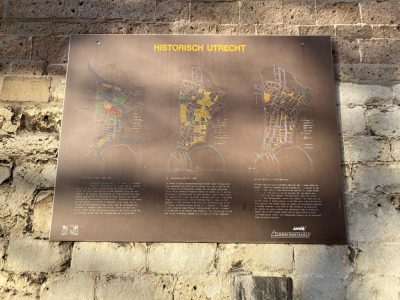Roman period and early Middle Ages
In 47 AD. the Romans founded a border fortress of wood and earth on the Rhine: ‘Trajectum'. Civilians lived east and west to the border, and they provided the soldiers from the fortress with what they needed.
In about 200 AD. the fort was built in stone. Sixty years later, the Romans disappeared. Significant habitation was resumed from around 690: St. Willibrord, the first bishop of Utrecht, founded the St. Maartenskerk or Dom and the St. Salvatorkerk in the remains of the old fortress. From this fort he converted the Frisians. After the invasions of the Normans, Utrecht received powerful bishops as rulers. Between 1040 and ca. 1100 they built, among other things, the cross of churches around the Dom. The traders lived on the Rhine and the Vecht, which were connected by the northern part of the Oude Gracht.
Medieval town 1122-1580
The churches and small trading settlements were protected from 1122 by ramparts with towers and four gates. The southern part of the Oude Gracht and the Vaartse Rijn provided a good trade route. Countless new churches and monasteries left their mark on the city, which was the largest in the Netherlands. The rich lived in large stone houses, for example along the Oude Gracht, the poor in dining-rooms in the narrow alleys. The Nieuwe Gracht, Drift and Plompetorengracht were dug in 1391. In 1528 Charles V took power from the bishop. He had the castle Vredenburg built and four stone bastions. In 1576 Utrecht revolted against Phillips II: the Spaniards were expelled from Vredenburg and the castle was demolished. Shortly afterwards, the city went over to the Reformation, which, among other things, abolished the monasteries.
The city from the 17th to the 19th century
In Fear of the Spanish attacks, a number of earthen strongholds were built. The breakdown of the monasteries and large churches created a lot of space in the city. New streets and large houses were constructed. The city went through a blooming period. On August 1, 1674, Utrecht was hit by a tornado, many (church) buildings were damaged and the middle part of the Dom collapsed. After that, not much was built in the city until the 19th century. However, churches and parts of the monasteries were demolished or completely renovated. Between 1830 and 1860, the city walls and gates disappeared, making way for public gardens along the outer city canal. It was not until after 1870 that Utrecht expanded beyond its medieval perimeter on a large scale. The medieval character of the city center has largely been preserved.

